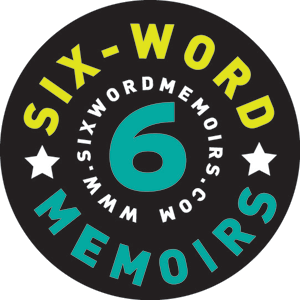
Yes! It is possible because we use our interpretation and imagination to read these memoirs (challenges the user and us as the audience to think). When we think of the meaning of memoir, we usually associate it with words like life narratives, personal experiences, diaries, and most of all- MEMORIES. Out of one word, we can interpret it so many different ways; then six-words mean six times the interpretation. One thing about having to research and present a specific topic is that afterwards, there is a restless feeling to that topic, the feeling of not wanting to go back or even look at that topic again. I thought that that might be the case for Six-Word Memoirs, but I was wrong. The presentation that my group and I put together for ASTU, actually raised more questions that are worth exploring and can be answer through further exploration of the site. However, one question that particularly struck me was what is the point restricting users to six-word expression of memoirs, if the option of posting a backstory was also available on the site? This never seem to be an issue for me when I went through the site, especially since I found the backstories just as intriguing as the six-word memoirs themselves. Nevertheless, I started thinking more and more about the bigger issue of how some websites don’t stick to their original ideas or how their original ideas gets molded by users of the site (and other internet audience) to create new features. Therefore, in the case of Six-Word Memoirs, the backstory feature was provided as the additional option for sharing their personal experience in depth, which in turn created conversations among users that build a socializing platform (community) for the website.
This new imagery of online social networks is my generation of community-building and to be a part of it, is like building history. However, I constantly find it easier to communicate face-to-face or within a class discussion. The way words are vocally communicated into the atmosphere in front of us and to be able to hear our voices, which is one of the reasons why we like listening to music. At this moment in life, the experience of the these two communities complement each other, but down the road, our reliance on technology to communicate might negatively affect our ability to confidently communicate face-to-face. There is for sure, aspects like the YouTube community where users compose their own videos (contain their own personal opinions, experience, singing, etc) and post them online to friends, family but most of the time strangers, while being completely comfort in that fact. This issue of comfort is also worth discussing, which was touched upon by the PostSecret ASTU presentation group. Who are we most comfortable in expressing ourselves to? Surprisingly, for many of us the answer is STRANGERS. This kind of concept remind me of The Witness Protection Program (Canada version), although I am not closely familiar with this program, I do find it comparable to the issue of comfort/safety around strangers. Falcon who interviewed Gerald Shur , who “was an attorney in what was then the Justice Department’s Organized Crime and Racketeering Section in the 1960s” reported that the idea is to “take the witness and the witness’ family and move them to another area”. For certain people, after living in a place for too long, travelling or moving to a new place for a new start is refreshing. But having to move for security reasons and to completely start over with their family, when they are in the case of stability is extremely difficult. Luckily, technology as a mean of communication can help to maintain relationships. Unfortunately, present day “witness protection program faces the added burdens of the digital age. Facebook, Google, texting and the instant access to information via the Internet and smartphones provide new challenges to keep the identities of witnesses a secret” (Falcon). Once again, in reality we often find ourselves stuck in the middle between the realm of online and offline social communities, and until this problem gets solved, we can only do what we can to co-exist on both sides.
One last point that I want to make is my lack of optimism towards online social networks (Facebook specifically) and the overall safety of the internet. Although, the internet is a place that we constantly depend on, it is hard to perceive it as a safe place to share, with the knowledge that hackers, companies, and even government institution have access to our private information/data is haunting. It almost seem inevitable for normal citizens, like myself to prevent such information from being revealed (Eli Pariser: Beware online “filter bubbles”; where I learned about the usage of Google and search refined to personal customization). I guess at the end of the day, I would rather choose privacy over efficiency and live in the past where internet was unavailable. However, this is probably not how I would think if I actually lived during that time period. All I know is that the direction that we are headed may make it possible to travel back in time, but until that day, we (mostly I) need to remind ourselves not to take these efficiency of technology for-granted.
Emily K
P.S. Six-Word Memoirs have a new feature: “TOP SIX”
Work Cited:
Falcon, Gabriel. “Inside the witness protection program.” CNN Justice 16 February 2013. CNN, 27 Oct. 2013 <http://www.cnn.com/2013/02/16/justice/witness-protection-program/>.



